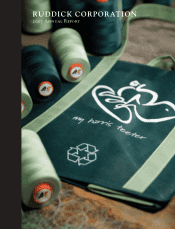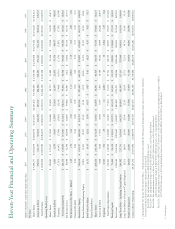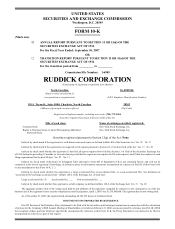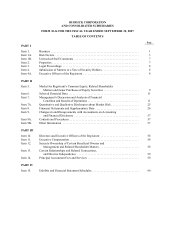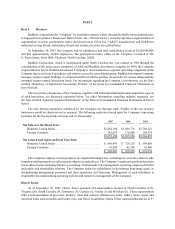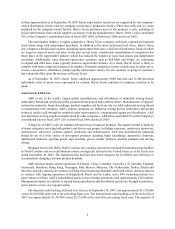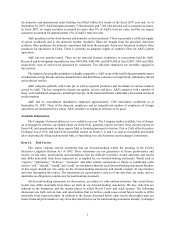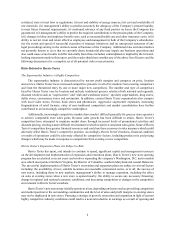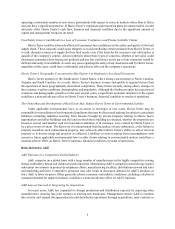Harris Teeter 2007 Annual Report Download - page 6
Download and view the complete annual report
Please find page 6 of the 2007 Harris Teeter annual report below. You can navigate through the pages in the report by either clicking on the pages listed below, or by using the keyword search tool below to find specific information within the annual report.2
of their supermarkets as of September 30, 2007. Retail supermarket operations are supported by two company-
owned distribution centers and one company-owned dairy production facility. Other than milk and ice cream
produced by the company-owned facility, Harris Teeter purchases most of the products it sells, including its
private label brands, from outside suppliers or directly from the manufacturers. Harris Teeter’s sales constituted
91% of the Company’s consolidated sales in fiscal 2007 (89% in both fiscal 2006 and fiscal 2005).
The supermarket industry is highly competitive. Harris Teeter competes with local, regional and national
food chains along with independent merchants. In addition to the more traditional food stores, Harris Teeter
also competes with discount retailers (including supercenters that carry a full line of food items), many of which
are larger in terms of assets and sales. In the past several years, considerable consolidation of competitors has
taken place in the supermarket industry which has reduced the number of local food chains and independent
merchants. Additionally, some discount supercenter operators, such as Wal-Mart and Target, are continuing
to expand and offer more items typically found in supermarket formats. As a result, Harris Teeter is likely to
compete with more, larger food chains in its markets. Principal competitive factors include store location, price,
service, convenience, cleanliness, product quality and product variety. No one customer or group of customers
has a material effect upon the business of Harris Teeter.
As of September 30, 2007, Harris Teeter employed approximately 9,900 full-time and 11,200 part-time
individuals, none of whom were represented by a union. Harris Teeter considers its employee relations to be
good.
American & Efird, Inc.
A&E is one of the world’s largest global manufacturers and distributors of industrial sewing thread,
embroidery thread and technical textiles, produced from natural and synthetic fibers. Manufacturers of apparel,
automotive materials, home furnishings, medical supplies and footwear rely on A&E industrial sewing thread
to manufacture their products. A&E’s primary products are industrial sewing thread, embroidery thread and
technical textiles sold through its employed sales representatives, commissioned agents and distributors. A&E
also distributes sewing supplies manufactured by other companies. A&E sales constituted 9% of the Company’s
consolidated sales in fiscal 2007 (11% in both fiscal 2006 and fiscal 2005).
A majority of A&E’s sales are industrial thread for use in apparel products. The apparel market is made up
of many categories servicing both genders and diverse age groups, including jeanswear, underwear, menswear,
womenswear, outerwear, intimate apparel, workwear and childrenswear. A&E also manufactures industrial
thread for use in a wide variety of non-apparel products including home furnishings, automotive, footwear,
upholstered furniture, sporting goods, caps and hats, gloves, leather products, medical products and tea bag
strings.
Headquartered in Mt. Holly, North Carolina, the company operated seven modern manufacturing facilities
in North Carolina and seven distribution centers strategically located in the United States as of the fiscal year
ended September 30, 2007. The manufacturing facilities have been designed for flexibility and efficiency to
accommodate changing customer product demands.
A&E also has wholly-owned operations in Canada, China, Colombia, Costa Rica, El Salvador, England,
Guatemala, Honduras, Hong Kong, Nicaragua, Italy, Mexico, Malaysia, The Netherlands, Turkey, Poland and
Slovenia; majority-owned joint ventures in China (two), Dominican Republic and South Africa; minority interest
in ventures with ongoing operations in Bangladesh, Brazil and Sri Lanka; and a 50% ownership interest in a
joint venture in China. A&E’s consolidated assets in these foreign operations total approximately $152 million.
Management expects to continue to expand foreign production and distribution operations, through acquisitions,
joint ventures or new start-up operations.
The domestic order backlog, believed to be firm, as of September 30, 2007, was approximately $11,576,000
versus $12,925,000 at the end of the preceding fiscal year. The international order backlog as of the end of fiscal
2007 was approximately $3,387,000 versus $1,271,000 at the end of the preceding fiscal year. The majority of

